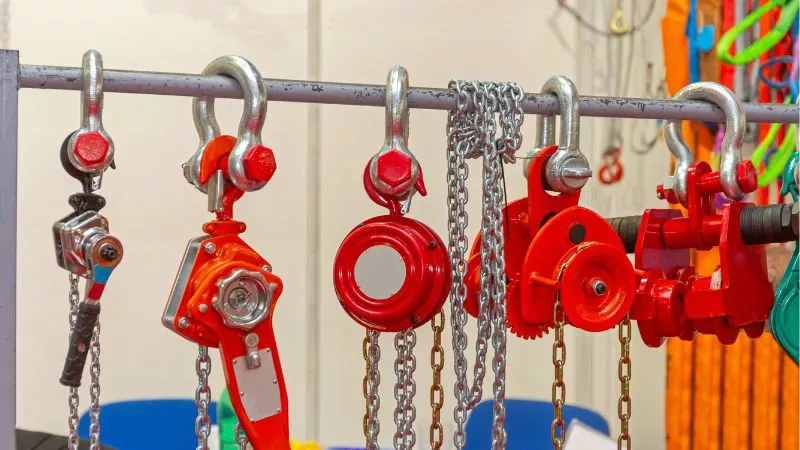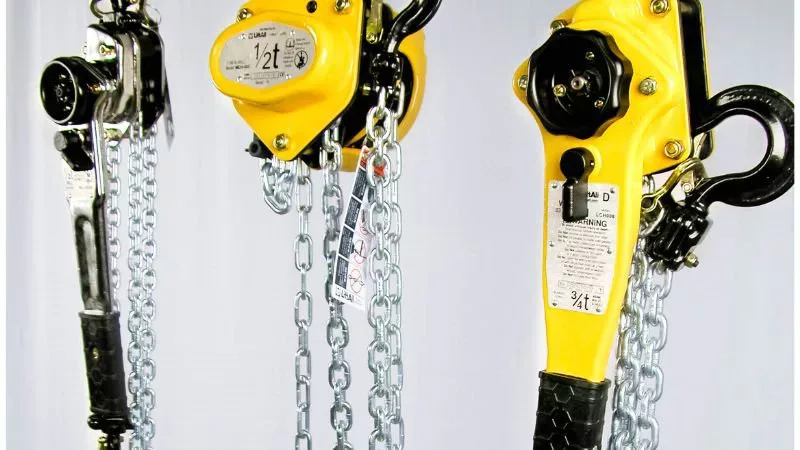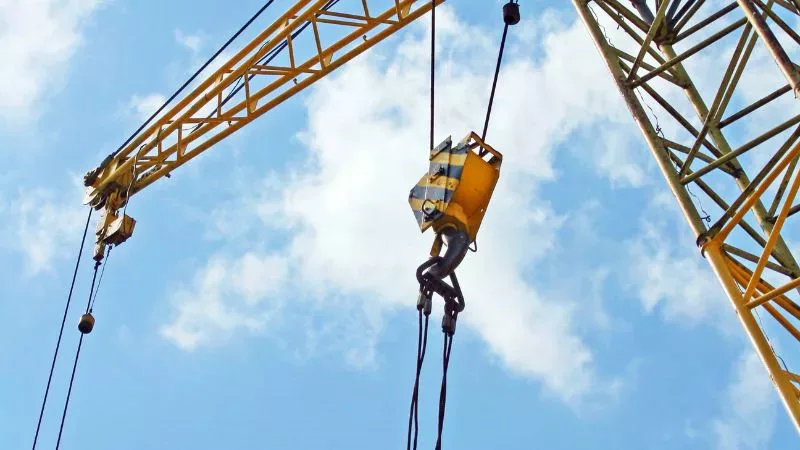
A hoist is a mechanical device that helps to raise or lower heavy loads by means of a drum or lift wheel around which a rope or chain wraps. It is commonly used to lift heavy objects and move them to a desired location. The industries that use cranes most frequently are construction, manufacturing, and transportation.
This article provides comprehensive instructions on different types of hoists and their applications. Your understanding of hoists is key for selecting the right equipment for the job, ensuring efficiency, and maintaining safety.
Functions of Hoists
Vertical Lifting: Originally, hoists lift loads vertically. It uses a chain or rope wrapped around a drum or wheel to pull the load upwards against gravity.
Lowering Loads: In addition to lifting, a hoist also safely lowers and deposits heavy objects. The lifting medium (chain or rope) is gradually released in a controlled manner to bring the load down.
Suspending Loads: Hoists can keep heavy objects suspended at a desired height for extended periods. This is useful for tasks that require materials to be held aloft, such as in construction or manufacturing.
Pulling/Dragging: Some types of hoists, like lever hoists, can also be used to pull or drag heavy objects horizontally in addition to vertical lifting.
Mounting Options: Hoists can be mounted in various configurations – hook-mounted, lug-mounted, or trolley-mounted on overhead runways. This allows them to lift and move objects through different spaces.
Powered Lifting: While some hoists are manually operated, most industrial hoists are powered by electricity, compressed air, or hydraulics. The power source enables the hoist to lift extremely heavy loads that would be impossible to move by hand.
Different Types of Hoists
In exploring the variety of hoisting equipment available, you’ll see the key differentiators in their operation method and lifting medium. Depending on your specific needs—be it load capacity, speed, or environment—there’s a hoist tailored for the task.
Manual Hoists

Manual hoists are versatile tools that allow operators to lift and move heavy loads using hand power. They are commonly used in construction, automotive repair, industrial settings, and other applications where lifting equipment is needed, but power sources may not be readily available.
Hand chain hoists – operated by pulling the hand chain, which turns gears to lift the load chain and hook
Lever hoists (ratchet hoists) – use a ratcheting lever to lift loads, can pull horizontally or vertically
Advantages of Manual Hoists:
- Do not require electricity or air power, making them portable and usable anywhere
- The simple design allows for easy maintenance and repair
- Typically more affordable than powered hoists
- The compact size is ideal for use in tight spaces
Electric Hoists
Electric hoists are material handling equipment used to lift, lower, and transport materials and products. They are powered by electric motors and equipped with controllers to adjust lifting parameters. They are capable of carrying heavy loads efficiently and can perform lifting tasks that would be impractical and unfeasible using conveyors and cranes.
Chain hoists – Use a load chain to lift and lower loads. They are compact, portable, and suitable for light to moderate loads in workshops, warehouses, and production facilities.
Wire rope hoists – Use a steel wire rope for lifting. They can handle heavier loads at higher lift heights than chain hoists and are used in construction, transportation, and industrial settings.
Electric Belt Hoists-use a belt made of strong synthetic fibers like polyester or Dyneema as the lifting medium, instead of a metal chain or wire rope. Due to its safety and durability, it is frequently used in the fields of cleaning, food, pharmaceutical, and aerospace engineering.
Advantages of Electric Hoists:
- Affordable and cost-effective compared to other lifting equipment like hydraulic hoists or forklifts.
- Silent operation with minimal noise generation, making them suitable for indoor use.
- Versatile and can lift a variety of loads with ease.
- Durable and long-lasting when properly maintained.
- Easy to install and intuitive to use.
- Faster lifting speeds compared to pneumatic hoists and manual hoists
Hydraulic Hoists
Hydraulic hoists are a type of lifting equipment that uses hydraulic power to raise and lower heavy loads.
Advantages of Hydraulic Hoist:
- Smooth, stable lifting – The hydraulic system allows for very smooth and stable lifting and lowering of loads.
- Safety – If a hydraulic line breaks or leaks, the hoist will lower slowly rather than dropping the load, providing an element of safety.
- Low maintenance – Hydraulic hoists have few moving parts compared to chain and cable hoists, making them relatively easy and inexpensive to maintain.
Pneumatic Hoists
Pneumatic hoists consist of an air motor that converts the energy of compressed air into mechanical energy to drive a lifting mechanism, typically a chain or wire rope. The lifting medium is wrapped around a drum or lift wheel, which raises or lowers the load as the motor turns in the corresponding direction. It includes three main categories: chain, wire rope, and piston.
Pneumatic chain hoists – use a chain as the lifting medium. They are durable, reliable, and suitable for most general lifting applications.
Pneumatic wire rope hoists – use a wire rope for lifting. They often provide faster lifting speeds than chain hoists and minimize sparking hazards
Pneumatic piston hoists – employ a piston and cylinder mechanism to create a linear lifting force
Advantages of Pneumatic hoist:
- Duty cycle: Pneumatic hoists can operate continuously with a 100% duty cycle without overheating, thanks to their self-cooling motors.
- Safety: Pneumatic hoists are intrinsically safe for use in potentially explosive environments like oil rigs, mines, and paint shops.
- Weatherproofing: Pneumatic hoists are not subject to IP ratings and can operate in outdoor and humid conditions without issues.
Applications of Hoists
Construction and Manufacturing Settings
Construction and manufacturing settings often require robust hoisting systems like electric hoists or pneumatic hoists due to their ability to lift heavy machinery and materials. Electric hoists are suitable for operations where electricity is readily available, offering high lifting capacities and speeds, necessary for handling heavy loads like building materials or manufacturing components. Pneumatic hoists are favored in potentially explosive environments or where consistent operation is required without overheating.
In warehouses and manufacturing facilities, manual chain hoists might be used for smaller loads, providing an economical and portable solution.
Overhead cranes frequently utilize electric or pneumatic hoists, which provide the capability to move objects with significant weight over large expanses within a facility.
Medical Industry
Hydraulic hoists are used in hydraulic patient lifts, which can safely transfer patients to bathtubs, toilets, beds, or wheelchairs in medical facilities.
Heavy-duty production environments
Pneumatic Hoists with 100% duty cycle are widely used in flammable, explosive, high temperature, high dust, and corrosive workplaces in industries such as chemical, textile, painting, logistics, and docks. They are suitable for explosive or hazardous environments as they eliminate the need for an electric power supply.
Selecting the Right Hoist

Once capacity and lift height are defined, you can focus on selecting a hoist type that will offer ease of use and customer satisfaction. Powered hoists come in electric, air/pneumatic, and hydraulic varieties, each offering different advantages and disadvantages depending on the use case, such as:
- Manual Hoist: suitable for precisely positioning and landing loads and ideal for removing cars and trees.
- Electric Hoists: Ideal for frequent use with higher duty cycles.
- Hydraulic Hoists: Often used in heavy-duty lifting in construction and maritime industries.
- Air/Pneumatic Hoists: Excel in volatile environments where electricity poses a risk.
Factors such as load chain quality, lift speed, and mechanical advantage must also be considered. Decide between a manual or powered hoist based on the ease of use required for your applications. The presence of a pulley block might be necessary if the load requires redirecting during lifting or if you’re seeking to gain a mechanical advantage. Keep in mind that frequent lifting at or near the hoist’s maximum capacity requires a hoist with a suitable duty cycle to accommodate the workload without incurring premature wear.
- Lift Speed: Relates to how fast the hoist can raise and lower loads.
- Pulley System: Can offer a mechanical advantage for heavier loads.
- Duty Cycle: Determines how frequently and intensively the hoist can be used.
Your final decision on purchasing a hoist should strike a balance between technical specifications and practical requirements, ensuring the selected hoist adds value and efficiency to your work processes.

